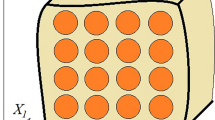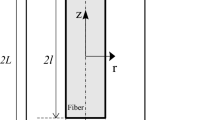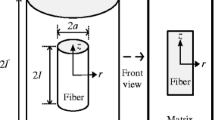Abstract
A new analytical approach is proposed to analyze the steady state creep in a short fiber composite SiC/Al6061 (Silicon Carbide/Aluminum 6061) under axial load based on high order displacement functions. The creep behavior of the matrix is described by an exponential law, while the fibers behave elastically. The main originality and purpose of the present paper is to predict the creep behavior in the short fiber composite “Silicon Carbide/Aluminum 6061 using high order functions analytically. The paper is presented in order to prevent undesirable events, as well as controlling the creep deformation rate. Good agreements are found among available experimental methods, FEM and present analytical approach results. As a result, most behaviors have ascending behaviors with smooth gradients, and also are controllable.
Similar content being viewed by others
References
Lauke B, Schultrich B (1983) Deformation behaviour of short-fibre reinforced materials with debonding interfaces. Compos Sci Technol 19(2):111–126
Hsueh CH (1992) Interfacial debonding and fiber pullout stresses of fiber-reinforced composites Part VII: improved analysis for bonded interfaces. Mater Sci Eng A 154:125–132
Nayfeh AH, Abdelrahman WG (1998) Micromechanical modeling of load transfer in fibrous composites. Mech Mater 30:307–324
Cox HL (1952) The elasticity and strength of paper and other fibrous materials. Br J Appl Phys 3:72–79
Mileiko ST (1970) Steady state creep of a composite with short fibres. J Mater Sci 5:254–261
Fukuda H, Chou TW (1981) An advanced shear-lag model applicable to discontinuous fiber composites. J Compos Mater 1(15): 79–91
McLean M (1985) Creep deformation of metal–matrix composites. Compos Sci Technol 23:37–52
Zhang J (2003) Modeling of the influence of fibers on creep of fiber reinforced cementitious composite. Compos Sci Technol 63(13):1877–1884
Morimoto T, Yamaoka T, Lilholt H, Taya M (1988) Second stage creep of silicon carbide whisker/6061 aluminum composite at 573 K. J Eng Mater Technol 110:70–76
Guo X, Lu W, Wang L, Qin J (2014) A research on the creep properties of titanium matrix composites rolled with different deformation degrees. Mater Des 63:50–55
Monfared V, Daneshmand S, Reddy JN (2015) Rate dependent plastic deformation analysis of short fiber composites employing virtual fiber method. J Comput Sci 10:26– 35
Monfared V, Mondali M, Abedian A (2012) Steady state creep behavior of short fiber composites by mapping, logarithmic functions (MF) and dimensionless parameter (DP) techniques. Arch Civ Mech Eng 12(4):455–463
Monfared V, Mondali M, Abedian A (2013) Steady state creep analysis of polymer matrix composites using complex variable method. Proc Inst Mech Eng C J Mech 227(10):2182– 2194
Monfared V, Mondali M, Abedian A (2013) Novel mathematical approaches for analyzing time dependent creep deformations in reinforced metals. J Mech Sci Technol 27(11):3277– 3285
Fatoba OS, Popoola O, Popoola API (2015) The effects of silicon carbide reinforcement on the properties of Cu/SiCp composites. Silicon 7(4):351–356
Nairn JA (1997) On the use of shear-lag methods for analysis of stress transfer in unidirectional composites. Mech Mater 26(2):63–80
Beyerlein IJ, Landis CM (1999) Shear-lag model for failure simulations of unidirectional fiber composites including matrix stiffness. Mech Mater 31(5):331–350
Nairn JA, Mendels DA (2001) On the use of planar shear-lag methods for stress-transfer analysis of multilayered composites. Mech Mater 33(6):335–362
Mondali M, Monfared V, Abedian A (2013) Non-linear creep modeling of short fiber composites using hermite polynomials, hyperbolic trigonometric functions and power series. C R Mec 341(7):592–604
Monfared V, Mondali M (2014) Semi-analytically presenting the creep strain rate and quasi shear-lag model as well as FEM prediction of creep debonding in short fiber composites. Mater Des 54:368–374
Monfared V (2015) A displacement based model to determine the steady state creep strain rate of short fiber composites. Compos Sci Technol 107:18–28
Monfared V, Daneshmand S, Monfared A H (2015) Effect of atomic number and atomic weight on time-dependent inelastic deformation in metals. Kov Mater Met Mater 53(2):85–89
Monfared V, Daneshmand S (2015) On the use of special functions for analyzing the steady state creep in short fiber composites semi-theoretically. Mater Res 18(3):588–594
Monfared V (2016) Circular functions based comprehensive analysis of plastic creep deformations in the fiber reinforced composites. Appl Compos Mater 1–13, in press. doi:10.1007/s10443-016-9504-5 10.1007/s10443-016-9504-5
Morgunov R B, Koplak O V (2016) Deformation defects supporting quantum readout of 29 Si nuclear spins in Si: P deformed crystals. Silicon 8(2):331–336
Boyle JT, Spence J (1983) Stress analysis for creep, 1st edn. Butterworth-Heinemann, Southampton
Author information
Authors and Affiliations
Corresponding author
Rights and permissions
About this article
Cite this article
Monfared, V. Role of High Order Functions in Analysis of the Creep Behavior of a Short Fiber Composite “Silicon Carbide/Aluminum 6061”. Silicon 9, 339–345 (2017). https://doi.org/10.1007/s12633-016-9502-0
Received:
Accepted:
Published:
Issue Date:
DOI: https://doi.org/10.1007/s12633-016-9502-0




